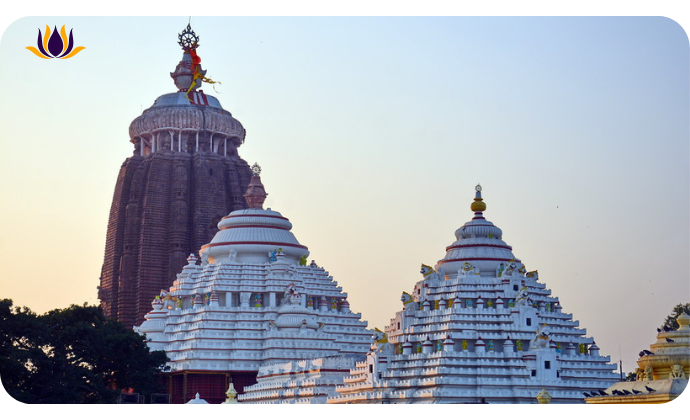Temple Built-In:- Jagannath Temple was constructed by King Chodaganga. The king started the construction, and Jaga mohan, the assembly hall, Vimana, or the temple chariot, were built during his reign. Later Anangabhima Deva completed the construction of the temple in 1174AD.
Temple History:- The temple was rebuilt by the Ganga dynasty king Anantavarman Chodaganga in the 10th century CE, as suggested by the Kendupatna copper-plate inscription of his descendant Narasimhadeva II. Anantavarman was originally a Shaivite and became a Vaishnavite sometime after he conquered the Utkala region (where the temple is located) in 1112 CE. An 1134–1135 CE inscription records his donation to the temple. Therefore, the temple construction must have started sometime after 1112 CE.
According to a story in the temple chronicles, it was founded by Anangabhima-deva II: different chronicles variously mention the year of construction as 1196, 1197, 1205, 1216, or 1226. This suggests that the temple’s construction was completed or that the temple was renovated during the reign of Anantavarman’s son Anangabhima.The temple complex was further developed during the reigns of the subsequent kings, including those of the Ganga dynasty and the Gajapati dynasty
Significance of the Jagannath Temple:- The Jagannath Puri temple is of great significance for the Hindus for ages. As per the belief, when the Pandavas started their journey to heaven to meet Yamraj, the Saptarishis advised them to first visit the ‘Chaar Dhaam’, Jagannath Temple is one of them.
The significance and importance of the temple can be gauged from the following occurring, which defies scientific logic. There are many mysteries, which people believe are actually ‘miracles’ that are blessings of Lord Jagannath. Some of these mysteries are:
1. The Jagannath Temple is constructed in such a way that it does not cast any shadow on the ground throughout the day.
2. The flapping of the flag is a mystery; the top of the temple has a flag that always flaps in the direction, which is opposite to the wind.
3. The 20 feet high chakra on the top of the temple is so positioned that the complete chakra is seen, from any part of the city. Where you are in the city, if you look at the chakra, the chakra seems to be facing you.
4. As per the belief, no birds or planes fly above the temple. The site is actually a no-fly zone, not declared by any government, but by some divine power.
5. According to an 1800-year-old ritual, the flag on the temple has to be changed every day. So, a priest climbs up every day atop the temple, which is as tall as a 45-storey building, to change the flag. The belief is that if this ritual is even once, the temple will remain shut for the next 18 years.
6. When you enter the temple through ‘Singha dwaar’, you can hear the sound of waves. But after passing the gate, if you simply turn and walk in the same direction, the sound will not be heard. In fact, the sound will not be heard as long as you are inside the temple.
7. The temple is visited by many devotees; the number varies anything between 2,000 to 20,000. The same quantity of prasadam is cooked every day. Yet, there has not been a single day, when prasadam got wasted or was insufficient for that day.
8. For cooking prasadam, 7 pots are used. These pots are placed one on top of another. The intriguing part is that the contents of the topmost pot get cooked first, followed by the bottom pots.
9. Neela Chakra symbolizes the protection by Shree Jagannath which is made of 8 metals with a height of 3.5 meters and a circumference of 11 meters.
Main Festival:- The biggest festival celebrated in the Puri temple is Rath Yatra also known as the car festival, which is celebrated in June or July, once during the month of Asadha of the Hindu calendar in this celebration all the trios are specially decorated, and pulled throughout to the main street of Puri (Bada Danda) to the Shri Gundicha temple so that devotees have the glimpse of the scared Rath Yatra.
Snaan Yatra is a bathing festival (On the Purnima of the month of Jyeshta), Sayan Ekadasi is celebrated on the evening of the 11th day of the bright fortnight of Asadha and some more major festivals are Chandan Yatra (in Akshaya Tritiya annually), Netrotsava, Chitalagi Amavasya, Srikrishna Janma, Bahuda Yatra, and Dussehra.
How to Reach:-
By Airway: The nearest airport is Biju Patnaik International Airport, which is just 3 km away from Bhubaneswar. There are regular flights for all major cities like Chennai, Mumbai, Visakhapatnam, Kolkata, Bangalore, New Delhi, etc.
By Railway: The nearest railway station is Puri, which is at a distance of just 3 km away from the Shree Jagannath Temple. There are regular direct trains from all major cities like Kolkata, Patna, New Delhi, Chennai, Bhubaneswar, etc.
By Roadway: Regular public and private buses and taxis are easily available at Puri because of the major railway junction of Puri and Bhubaneswar. Buses are interconnected to other nearby cities are Bhubaneswar (48 km), Cuttack (63 km), Brahmapur (124 km), and Jamshedpur (335 km).



Leave a Reply